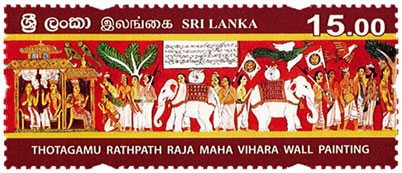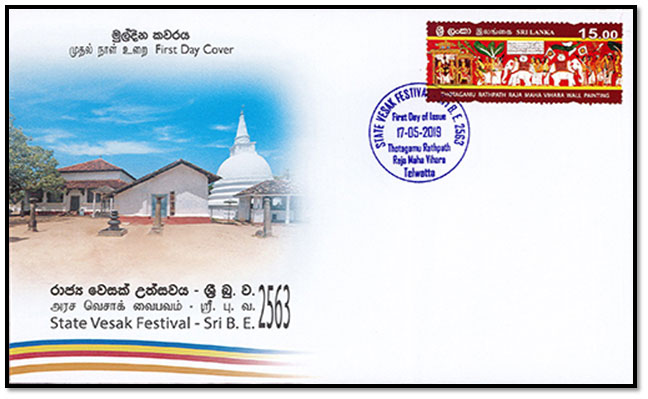

Home/Active Page

To commemorate the State Vesak Festival of Buddhist Era 2563, a new postage stamp of denomination Rs. 15.00 has Issued on 17th May 2019 by the Philatelic Bureau of the Department of Posts.
| Date of Issue | 17th of May 2019 |
| Denomination | Rs.15.00 |
| Catalogue No: | CSL 2327 |
| Stamp Designer | P.Isuru Chathuranga | Stamp Size: | 60mm x 25mm |
| Sheet Composition: | 20 stamps per sheet |

To commemorate the State Vesak Festival of Buddhist Era 2563, a new postage stamp of denomination Rs. 15.00 has Issued on 17th May 2019 by the Philatelic Bureau of the Department of Posts.
Among the historic sacred Vihāras in Sri Lanka, the Telwatta Purāna Thotagamu Rathpath Raja Maha Vihāra holds a very special place. Known as the ‘Rahathpath Vehera’ in early times due to it being the abode of five hundred ‘Rahathan Vahansela’ (monks who had arrived at the status of Arahat), it is known today as Rathpath Vehera, and is situated in the Galle District in the Southern Province.
According to legend Thotagamu Rathpath Raja Maha Vihāra was first built by Uparaju (viceroy) Mahānāga, brother of King Devānampiyatissa. Uparaju Mahānāga, after avoiding attempted murder by Queen Anula who sent him poisoned mangoes, was journeying with his retinue to the southern part of Sri Lanka known as Ruhuna when he came to Thotagamuwa, an old port city. Folklore mentions that Uparaju Mahānāga subsequently built the Vihāra at Thotagamuwa and offered it to the enlightened monks.
There is a school of thought that it was at this place that King Sakra created a statue to save the country from the great incursion of the sea that took place in the second century B.C. as a result of King Kælanitissa killing an Arahat monk in a cauldron of oil, and to enshrine Buddhism for all time in the country.
While the Kotte Era is considered the golden era of the Thotagamu Rathpath Raja Maha Vihāra, this was also the temple of Shadbāsha Parameshwara, Thripitaka Vagishwaracharya, and great poet of Sinhale´ Thotagamuve´ Sri Rāhula Himi. It was also at this Vihāra that the Most Venerable Hikkaduwe´ Sri Sumangala Thero entered into the monkhood.
The base of the Vijayaba Pirivena which belongs to the Anuradhapura period, the ancient sacred Bo tree, the old Chetiya, the two shrine rooms with the paintings and murals from the Kandyan period, the two Devālas, the consecrated treasury building, the old living quarters of the monks and the stone pillar, the Dhamma Recitation Hall that are at this place are all monuments that speak of its ancient history. This Vihāra, which from its beginnings enjoyed unstinted patronage of various kings, is today the subject of respect and veneration by people from here and abroad
All rights received. All right to identify the Department of Posts as the Author and designer of this Bulleting has been asserted in accordance with the Copyright, Design and Patents Act 1988.No part to this publication may be reproduced, stored in or introduced into a retrieval system, or transmitted in any form or by and means (electronic, mechanical, photocopying, recording or otherwise) without the prior permission from the publisher. Any person who does and unauthorized act in relation to this publication may be liable to criminal prosecution and civil claims for damages.